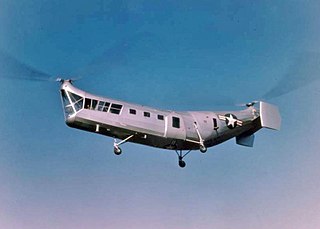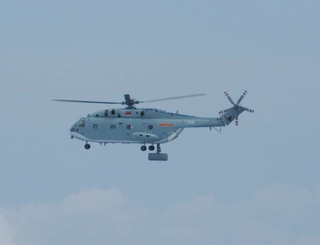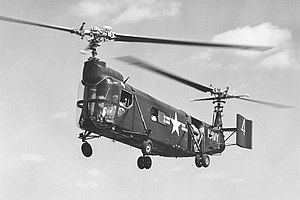
The Kamov Ka-25 is a naval helicopter, developed for the Soviet Navy in the USSR from 1958.

The Kaman SH-2 Seasprite is a ship-based helicopter originally developed and produced by American manufacturer Kaman Aircraft Corporation. It has been typically used as a compact and fast-moving rotorcraft for utility and anti-submarine warfare missions.

The Sikorsky SH-60/MH-60 Seahawk is a twin turboshaft engine, multi-mission United States Navy helicopter based on the United States Army UH-60 Black Hawk and a member of the Sikorsky S-70 family. The most significant modifications are the folding main rotor and a hinged tail to reduce its footprint aboard ships.

The Bell 212 is a two-blade, medium helicopter that first flew in 1968. Originally manufactured by Bell Helicopter in Fort Worth, Texas, United States, production was moved to Mirabel, Quebec, Canada in 1988, along with all Bell commercial helicopter production after that plant opened in 1986.

The Bell XV-15 is an American tiltrotor VTOL aircraft. It was the second successful experimental tiltrotor aircraft and the first to demonstrate the concept's high speed performance relative to conventional helicopters.

The Bell Helicopter Eagle Eye, Model 918, was an American tiltrotor unmanned aerial vehicle that was offered as one of the competitors in the United States Navy's VT-UAV program.

The Focke-Achgelis Fa 223 Drache was a helicopter developed by Germany during World War II. A single 750-kilowatt (1,010 hp) Bramo 323 radial engine powered two three-bladed 11.9-metre (39 ft) rotors mounted on twin booms on either side of the 12.2-metre-long (40 ft) cylindrical fuselage. Although the Fa 223 is noted for being the first helicopter to attain production status, production of the helicopter was hampered by Allied bombing of the factory, and only 20 were built.

The Bristol Type 192 Belvedere is a British twin-engine, tandem rotor military helicopter built by the Bristol Aeroplane Company. It was designed by Raoul Hafner for a variety of transport roles including troop transport, supply dropping and casualty evacuation. It was operated by the Royal Air Force (RAF) from 1961 to 1969. The Belvedere was Britain's only tandem rotor helicopter to enter production, and one of the few not built by Piasecki or Boeing.

The Sikorsky CH-53K King Stallion is a heavy-lift cargo helicopter designed and produced by Sikorsky Aircraft. The King Stallion is an evolution of the long running CH-53 series of helicopters which have been in continuous service since 1966, and features three uprated 7,500 shp (5,590 kW) engines, new composite rotor blades, and a wider aircraft cabin than its predecessors. It is the largest and heaviest helicopter in the U.S. military.

The Bristol Type 173 was a British twin-engine, tandem rotor transport helicopter built by the Bristol Aeroplane Company. It was designed by Raoul Hafner as a civil transport helicopter but evoked interest from the military. It did not enter production but was developed into the Bristol Belvedere which was operated by the Royal Air Force from 1961 to 1969.

The Ling-Temco-Vought (LTV) XC-142 was a tri-service tiltwing experimental aircraft designed to investigate the operational suitability of vertical/short takeoff and landing (V/STOL) transports. An XC-142A first flew conventionally on 29 September 1964, and on 11 January 1965, it completed its first transitional flight by taking off vertically, changing to forward flight and finally landing vertically. Its service sponsors pulled out of the program one by one, and it eventually ended due to a lack of interest after demonstrating its capabilities successfully.

The Boeing Vertol YUH-61 was a twin turbine-engined, medium-lift, military assault/utility helicopter. The YUH-61 was the runner-up in the United States Army Utility Tactical Transport Aircraft System (UTTAS) competition in the early 1970s to replace the Bell UH-1 Iroquois helicopter. At the end of the flyoff program, Sikorsky Aircraft was awarded a contract to develop and build its UH-60A entry.

The Sikorsky S-60 helicopter, a prototype "flying crane", was derived from the S-56 in 1958. Proving to be underpowered, the development of the S-60 led to the larger, turbine-engined Sikorsky CH-54 Tarhe military transport helicopter, and its civil S-64 Skycrane variant, which were already on the drawing board by the time the sole example of the S-60 crashed on 3 April 1961.

The Piasecki HRP Rescuer is a United States tandem-rotor transport or rescue helicopter designed by Frank Piasecki and built by Piasecki Helicopter. The Piasecki PV-3 was adopted as the HRP-1 Rescuer by the United States Navy, United States Marine Corps, and United States Coast Guard. An improved PV-17 variant was later produced as the HRP-2. As one of the first transport helicopters in military service, the HRP-1 was capable of carrying two crewmen and 8-10 passengers or 2,000 lb. (907 kg) of cargo.

The Gyrodyne RON Rotorcycle was a tiny, single-seat helicopter designed under contract for the United States Navy. in the mid-1950s. It later was redesigned for a U.S. Marine Corps requirement for a small personal helicopter that would fulfill a number of roles, including observation, liaison, small unit tactical maneuvers, and which could be dropped to downed airmen behind enemy lines to facilitate their escape.

The Sikorsky S-52 is a utility helicopter developed by Sikorsky Aircraft in the late 1940s. It was used by the U.S. Navy, Marine Corps, and Coast Guard. The S-52 was the first US helicopter with all-metal rotor blades. Initially a two-seater, it was developed into the four-seat S-52-2 and S-52-3. It was designated HO5S-1 by the U.S. Navy and Marine Corps, HO5S-1G by the Coast Guard, and YH-18A by the U.S. Army, and was used extensively by civil operators after being retired by the military.

The Bell V-280 Valor is a tiltrotor aircraft being developed by Bell and Lockheed Martin for the United States Army's Future Vertical Lift (FVL) program. The aircraft was officially unveiled at the 2013 Army Aviation Association of America's (AAAA) Annual Professional Forum and Exposition in Fort Worth, Texas. The V-280 made its first flight on 18 December 2017 in Amarillo, Texas.

The Harbin Z-20 is a Chinese medium-lift utility helicopter produced by the Harbin Aircraft Industry Group (HAIG). It was first flown on 23 December 2013 and has a maximum takeoff weight in the range of 10 tonnes (22,000 lb). The Z-20 can operate from locations above 4,000 m (13,000 ft) in altitude as well as from the Liaoning aircraft carrier. It is regarded to be comparable in performance to the US-made Sikorsky UH-60 Black Hawk helicopter, of which the civilian Sikorsky S-70C-2 variant has been used by the People's Liberation Army since 1984.

The Changhe Z-18, also known as Z-8G, is a medium-lift transport helicopter developed by Changhe Aircraft Industries Corporation (CAIC) to replace the Changhe/Harbin Z-8.

The Bell V-247 Vigilant is a concept by Bell Helicopter to develop a large tiltrotor unmanned aerial vehicle.




















